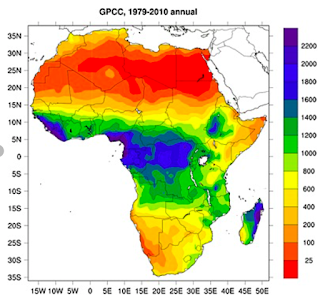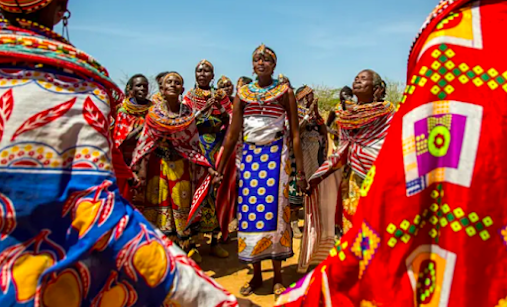4 - The root of the problem...
Before I move on to talk more about gender-related issues, I want to quickly explain the root of the problem: water insecurity. It is because of this that the task of water collection can be so difficult for women like Sabina - I feel it is only appropriate to explain why that is. As previously mentioned, Africa has plentiful water resources. Although it is the second driest continent on Earth, there is, in fact, enough water to support its population. So, why are 25 of its 54 countries either water-stressed or scarce (Gachanja et al, 2010)? Today I will shed some light on Africa’s water crisis.
Surface water
To start with, Africa’s surface water is highly variable, partly due to seasonal shifts of the Inter-Tropical Conversion Zone (ITCZ). The northwards movement of Hadley cells between January and August strongly affect precipitation patterns across the continent, and low levels of rainfall are brought to the already dry Sahara and Kalahari deserts.
Droughts: On the rise
Africa’s water issues can also be attributed to severe droughts. They are thought to be the continent's principal type of natural disaster and are the most common trigger of household insecurity (Calow et al 2010). While groundwater aquifers can be reliable, and do contribute to 75% of drinking water, droughts often see to their over-depletion (Gachanja et al, 2010). This occurs in the immediate vicinity of wells and boreholes, as higher demands in times of drought can reduce the transmissivity of such mechanisms (Calow et al 2010).
Is it clean?
A predominant issue for Africa’s water supply is that it can be unclean; around 50% of those in Sub-Saharan Africa do not have access to a safe water supply (Nalik, 2016); Somalia and Ethiopia are thought to have the highest rates of unsafe water access at 70% and 62% (Africa Public Health, 2012). Often, water may be exposed to human excrements or chemical contaminants found in bedrock, and without purification, diseases such as dysentery, cholera or typhoid can spread (Gachanja et al, 2010). I will talk more about sanitation issues from the standpoint of gender in my future blog posts.
Inadequate infrastructure
Another unmissable point for why Africa suffers from water insecurity is the inadequate infrastructure that exists in many areas. A study conducted in Ethiopia found that, in times of drought, over-use and stress often caused wells to break (Calow et al 2010). A recent podcast I listened to on the experiences of water collection for women in South Africa explained that old, non-functioning water pipes result in the loss of ‘1160 million cubic metres’ of water per year. Furthermore, I learnt that where water tanks are provided in South Africa, they aren’t regularly filled up, and often do not have stands, so water cannot be properly accessed (Climate Justice Coalition, 2020).
In many cases, it is that the infrastructure simply does not exist. Sabina had spent every day of her life since the age of 7 collecting water from over an hour away, however, ‘World Vision’ were able to supply her with a tap right on her doorstep, emphasising the point that Africa’s water issues largely stem from infrastructural insufficiency.
I have briefly spoken about some of the issues that cause water insecurity in Africa, and while I could go into more detail about each of them, I hope that I have effectively summarised some of the obstacles that the continent must face in its developmental approach. It is largely due to these factors that women like Sabina have to dedicate most of their time to providing water for their families, and so I feel that these issues are highly relevant in assessing why exactly the process of water collection can be so challenging.





Hey Heather, love the new blog post!! The structure is really clear and flows really nicely, which made for a great read. I like how you tackle the physical geography first and then bring its relevance into the human realm through inadequate infrastructure. I think your linking to Sabina, alongside the case studies and podcast you listened to, grounds the post in everyday lives and prevents people thinking about the science as being too abstract from individual people (which can happen easily when people start talking about Hadley cells etc!).
ReplyDeleteAs a small edit, might I suggest you hyperlink / add a picture of what the ITCZ looks like, just so we can see it in action?
Looking forward to the next one :)
Thanks for the feedback Fin, that's a great idea! I have added one in now, hope it helps!
DeleteNice work Heather. As Fin says above, the science-y elements can be complex to understand, but you have articulated it clearly!
ReplyDeleteThank You Sophia! I'm glad you enjoyed it :)
DeleteThis is a really well-written blog. You made complex ideas and processes easy to understand which can be very hard. As with most of your blogs, this is very well structured and easy to read. It would be useful if you could suggest some solutions to the problems highlighted like climate change/drought? Could you maybe hint at some solutions which you may explore in later blogs. Also, the way you link your blogs together is something really unique. I think for a lot of people most of their blogs feel like separate topics or essays, but for you, you've almost made a story which is amazing. Keep it up!
ReplyDeleteI agree with the comments above - I really enjoyed reading this blog from how well it flowed! You also went into depth on the important and evidently highly relevant physical factors affecting Africa's climate as well as future concerns of climate change. I think the interlink you then made between the physical and human aspects were crucial in truly understanding the basis of the complex issues at hand. This is a fantastic blog post that gives us a grounding to the issue in addition to helping more people to recognise Africa and its 54 countries are not one arid homogenous biome...
ReplyDelete